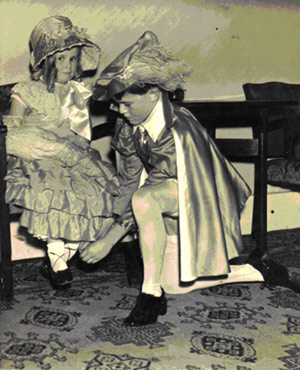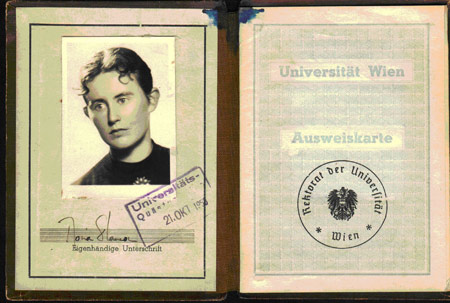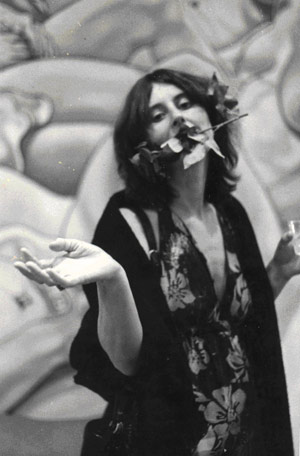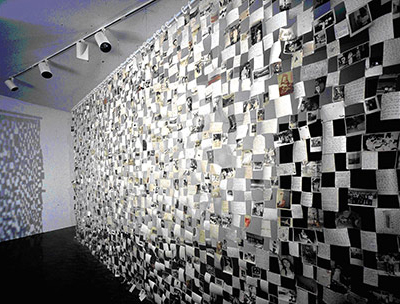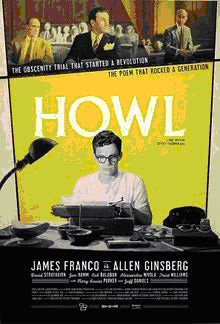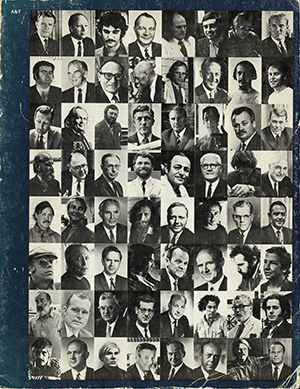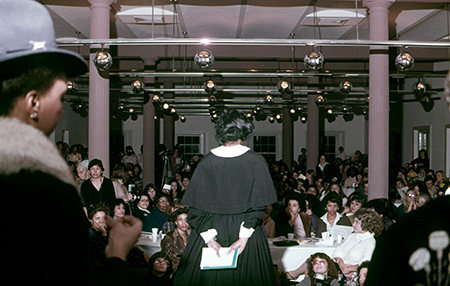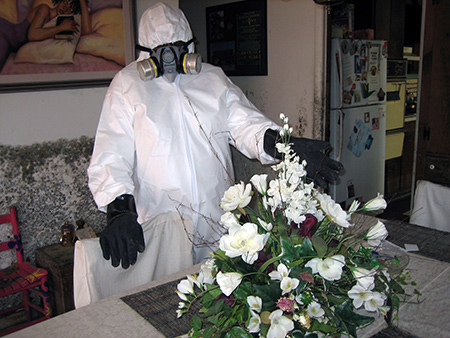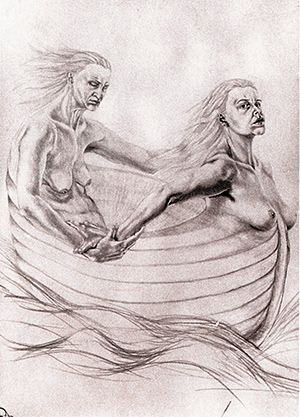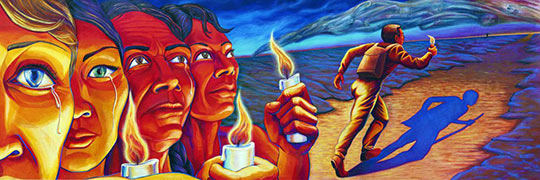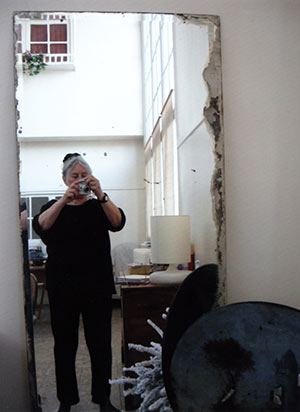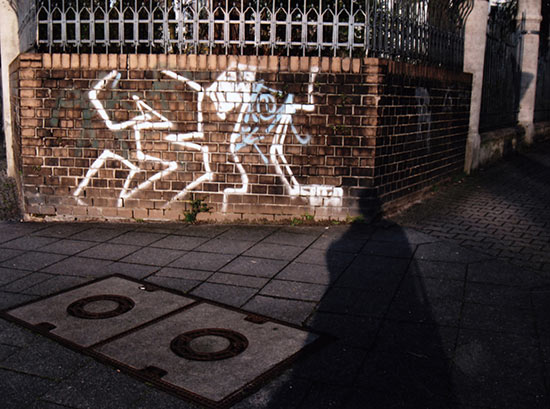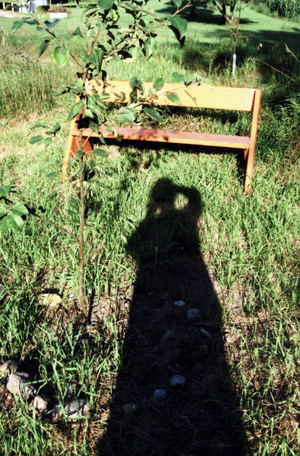All Over the Map, The Poor Farm, Wisconsin, Summer 2010
In July of 2010, an elaborate series of exhibitions and theater events titled All Over the Map was held in honor of my 77th birthday at the Poor Farm, a new art space in rural Wisconsin. This space, located in a renovated nineteenth-century building surrounded by farmland, was once part of the Midwest’s system of “Poor Farms,” somewhat akin to almshouses in England and the Armenhäuser in Germany.1
I had spent relatively little time in the Midwest (outside of briefly teaching in Chicago, Illinois and Bloomington, Indiana) and so this encounter gave me an illuminating glimpse into American geography and history I had not previously known. It became a springboard for thinking about my own life, about this country and its complex history(ies), and my own relationship to this history.
Among my birthday gifts at the Poor Farm was a total surprise: copies of some thirty-five snapshots of me, ranging from early childhood to the present, collected by the artist Suzanne Lacy, a close friend of mine for many years. She had sent them to Annika Marie (the co-organizer of this All Over the Map project) with instructions that they be “hidden in different nooks and crannies” in the main building at the Poor Farm. Over several days, I had the amazing experience of discovering—sometimes in a cupboard, sometimes in the drawer of a table, sometimes on a windowsill—forgotten images of myself:
A more adventuresome 20-year-old attending the University of Vienna.
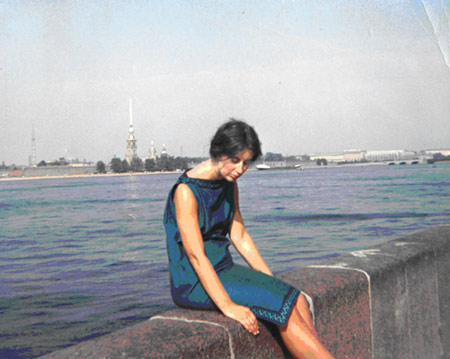
A daydreamer along the river in St. Petersburg in 1965.
A glamorously styled figure posing in California in 1970.
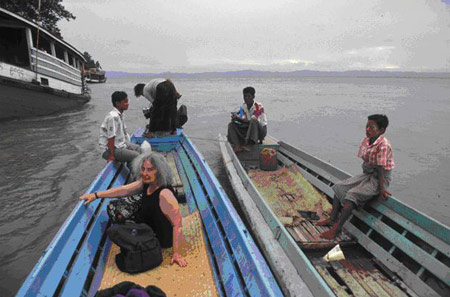
And the subject of a dramatic rescue from a sinking riverboat in Cambodia at
the end of the 1990s.
Searching for One’s Way Home, 2010–2011
These images stirred up recollections of disparate moments in my life. Yet even before encountering them, in May of 2010, I had begun to write a series of texts called Finding One’s Way Home. These texts (still ongoing) incorporate photographs of myself, internet references, and drawings by the Serbian-born, now San-Francisco-based, artist and theater director Slobodan Dan Paich. We have exchanged images and texts daily for the past two years.
The first Finding One’s Way Home texts are abstract and rather romantic. Part 1 describes a woman on an unknown island making her way through a forest, holding a bedraggled map and a notebook. She has been told:
That it would take her exactly
One year and a day
To find her way home.
By Part 16 the woman realizes that:
To continue finding her way home
She must leave the beach and the forest
On the island,
And must go to Europe
To find her mother.
In Part 17 I plunge—albeit poetically and still using the third-person singular to narrate the tale—into my own World War II childhood. The woman recalls:
Nightly hiding in the bomb shelter in the garden city of Letchworth,
Where she and her mother lived,
Hearing the German planes, the ‘doodlebugs,’
As they flew toward
Or away from London.
Part 18 describes the refugees from both continental Europe and London who stayed during the war with my mother and me in our home in Letchworth, some thirty miles outside London:
From Hungary,
Exuberant and witty,And Hans Redlich,
A Jewish musicologist and conductor,
From Vienna
(his father was the last Minister of Justice in the Austro-Hungarian Empire)
Who had lived in Germany with Liesl, his ballerina wife,
Until escaping from the Nazis in 1939,
And ending up in Letchworth during the war.She remembers,
Sitting with Hans and Liesl,
Listening to Monteverdi Vespers
The large Master’s Voice gramophone
In her mother’s living room upstairs
—decorated with expensive reproductions of Gauguin’s Tahitian paintings—That looked down on their garden
Of peonies, blackberries and roses.She remembers summer Sunday lunches in the garden
With musical visitors from LondonIncluding Frank Walker,
Who was researching his biography of Hugo Wolf,
And who later
—After she had returned from her first visit to the United States when she was age eighteen—
Was to put her in contact with Wolf’s illegitimate daughter
Who arranged for her to live
In a small village in Austria,
Gmunden,
While she learned German.
Decades later,
Living in Berkeley, California,
She listens to a Hugo Wolf song on YouTube
While she recalls her World War II childhood in Letchworth.
Reflections in the Café, Berkeley, August 31, 2010: Of Writing, Travels, Rachel Marker and Memories of My Childhood in Letchworth
I sit in a café near my Berkeley home, where I have gone to ever since I arrived back in Northern California in the mid-1980s. I come here each morning to have breakfast, read the New York Times and write—not on a laptop but in a notebook. Later, upon returning home, I input my handwritten texts and notes into my computer.
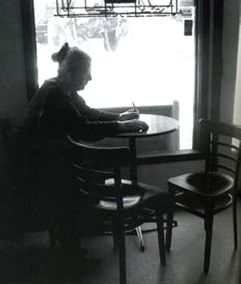 Me in Nabolom café, Berkeley, 2007. Photo by Laura Janku.
Me in Nabolom café, Berkeley, 2007. Photo by Laura Janku.
Over the last ten years or so I have become increasingly immersed in writing fiction, poetry, and plays, much of it inspired by my travels in Europe (Czechoslovakia, France, Germany, Greece, and Spain), Morocco, and Asia. The titles of four of my most recent and as-yet-unfinished series of texts will give, I hope, a sense of my sprawling interests: Traveling Companions/Fractured Worlds (1998–), The Library of Maps (2001–), From Far Away (2003–), and All Over the Map (2010–). A fifth project (also ongoing) relates to the voyaging in time and space of these series: Through the Eyes of Rachel Marker.
While staying in Berlin (a city I love) for three weeks in the summer of 2001, I invented Rachel Marker, a Czech Jew who composes daily letters to Franz Kafka after his death in 1924 as she moves through Europe’s twentieth-century history and its cities—living for years in Prague, visiting Madrid during the Spanish Civil War, moving to Paris in 1939, and after the end of World War II settling in Berlin, where she regains her memory (lost during the war) and takes daily photographs of the city’s shadows. The Rachel Marker narrative includes an almost alter ego character whom I have named Moira Marker, inspired, in part, by my own encounters with twentieth-century history and those of people I have known.
Today I sit here thinking about the war years in England, and about Paul Dienes and his family, and later the Redlichs. It was a tradition that we would always eat together—long, leisurely suppers accompanied by animated conversations about forgotten history and about music, literature, and art. These exchanges gave me an intimate, comfortable contact with European culture and history far beyond that of most English children at that time. For example, Hans introduced me to Sartre and existentialism when I was about fourteen. My education was furthered by my mother’s choice of a high school for me—unorthodox for its time (coeducational, vegetarian, and rather undisciplined!).
In Letchworth—the world’s first “garden city,” created in 1903 by Ebenezer Howard and located between London and Cambridge—the Theosophists had founded the Garden City Theosophical School in 1915, which was later renamed St. Christopher School (although it was not Catholic) and run by Quakers. It had an international student body, which included children from Africa and Persia (now Iran), as well as from continental Europe and, of course, England itself. Adding to this ethnic and cultural mix was a range of class backgrounds; for example, the students from the Gold Coast and Persia were upper class, whereas most of the English students were middle class. Further complicating the picture for me was the fact that my mother came from a very wealthy, upper-class Montreal family, whereas my father had been born into a working-class Belfast family and was the only one in his family to go to college. (My parents had divorced when I was very young.)
All this made me frequently feel rather “un-English” as a child, somewhat displaced yet knowing my childhood was unusually interesting and culturally rich.
My childhood contacts also left me with a lifelong closeness to Jewish culture, history, and people, although I myself am not Jewish. In addition to Paul Dienes and later the Redlichs, who continued to live with us after World War II, I was deeply influenced by a lifelong friendship with Rose Hacker, an English-born Jew, who with her family stayed with me and my mother for a while during the war.
After my mother’s death in 1978 Rose and I unofficially adopted one another, and we stayed in close contact until her own death in 2008 at age 101. She was a remarkable woman, active in politics, and participating in marriage guidance and mental health organizations. In the last year of her life she wrote bimonthly op-eds for a local London newspaper. Years ago, she gave me a small, tattered photograph of herself and her father (a dress designer) taken in Berlin in 1929. It is an image that has haunted me for years, and this summer I created a room at the Poor Farm in memory of Rose, which included a large vinyl blowup of this photograph that I had made for a theater production about Rachel Marker a few months after Rose’s death.
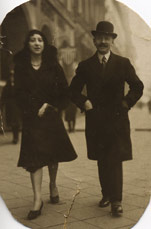 Rose Hacker and her father, 1929, Berlin.
Rose Hacker and her father, 1929, Berlin.
Reflections in the Café, Berkeley, September 15, 2010: Faith Ringgold
I’m thinking about this country and my relationship to it—from my first visit in 1950, when I was 17, to my experience of Wisconsin a few months ago to celebrate my 77th birthday.
Sixty years.
I first came to the U.S. in the early summer of 1950 to stay for a year with my father in Washington, DC, where he was working for the International Monetary Fund. The next spring I traveled alone and leisurely over some three months by Greyhound bus across the country and back, and north to Montreal to visit my mother’s family.
From the start, I was deeply attracted to the wide range of ethnic and cultural differences I found here, and this has stayed with me over the last six decades, despite the enormous shifts in American politics, culture, and economics, as well as in attitudes to race and racism. It has meant that as an art historian I have formed close and long-lasting contacts with artists in many diverse ethnic, cultural, and class circles (here and abroad), which have profoundly affected my understanding of this country and its history(ies) as well as of my own background.
For example, since 1980, when I first met her, I have become one of the main writers on the African American artist Faith Ringgold (who recently celebrated her 80th birthday).2 In 1995 I edited her wonderful autobiography, We Flew over the Bridge, and earlier we had traveled together to Morocco and Paris.
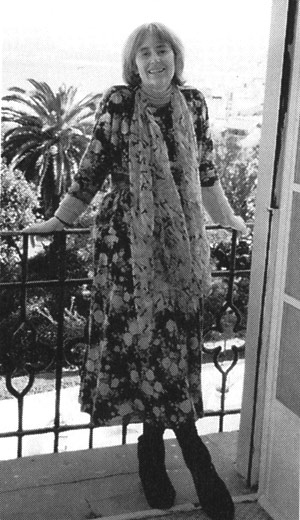 Me in Morocco, 1992. © Photo by Faith Ringgold.
Me in Morocco, 1992. © Photo by Faith Ringgold.
These trips, combined with my frequent visits to her home (first in New York and now in New Jersey), and hers to mine, have allowed me to follow firsthand the evolution of her Coming to Jones Road series (1999–), about a fictional escaped slave who brings her family to freedom, a narrative into which Ringgold weaves the history of her own family and New Jersey. I have also watched her develop her various story quilts, a form she invented, using images and handwritten texts surrounded by quilted borders.
Her story-quilt series The French Collection, begun in 1991, is set in France (with the last scene in Morocco), and in it the heroine, Willia Marie Simone, prepares herself to become an artist by first working as a model for Matisse and Picasso. The tables are reversed in Part 3, The Picnic at Giverny, in which Willia Marie stands boldly (as always garbed in an elegant white dress) in front of an easel in Monet’s famous Giverny garden as she paints a portrait of her friends, family, and admirers, who have gathered there. Below her, off to the side, is an obedient nude model—Picasso—posing as beguilingly as possible in the hopes of being included in Willia Marie’s painting. (I sit in a blue dress directly above him!)
[Picture removed for copyright reasons.]
© Faith Ringgold, The Picnic at Giverny, 1991, acrylic on canvas,
73.5″ ✕ 90.5″. The French Collection, no. 3.
After this, Faith Ringgold’s imagination does not hold back as she reexamines French literary and artistic modernism. For example, in Part 9 Ringgold inserts her heroine into Gertrude Stein’s salon, where Willia Marie listens bewitched to the black voices of Zora Neale Hurston, Langston Hughes, James Baldwin, and Richard Wright as they literally interrupt the historical white narrative of the Stein salon.
In the first scene of Ringgold’s next story-quilt series, The American Collection, Willia Marie’s daughter, Marlena, elegant and well educated, is returning to America from France and dreams that she is on a slave ship. But after she arrives in the U.S., she pursues a highly successful career as an artist, painting a portrait of two fiery Aunt Jemimas, as well as one of Frederick Douglass, Harriet Tubman, and Sojourner Truth.
[Picture removed for copyright reasons.]
© Faith Ringgold, We Came to America, 1997, acrylic on canvas,
74.5″ ✕ 79.5″. The American Collection, no. 1.
For the All Over the Map project at the Poor Farm, Ringgold contributed a series of her children’s books (she has created eleven since 1989). They were displayed in what I called the “history” room, which included material on the Wisconsin Underground Railroad.
[Picture removed for copyright reasons.]
© Faith Ringgold, Aunt Harriet’s Underground Railroad in the Sky, 1995, book cover.
Over the last thirty years, Ringgold’s work (her paintings, story quilts, sculpture, performances and children’s books) has not only deeply influenced my reading of American history, but also inspired me as a brilliant model for the blending of fact and fiction, something I am increasingly drawn to in my own work.
Reflections in the Café, Berkeley, September 27, 2010: Dinh Q. Lê
This morning, after I catch up with current news in the New York Times, I turn to musing about another artist, Dinh Q. Lê.
In my mind’s eye, the café disappears and I see his huge photo-weavings and photo-tapestries, which I have studied at length, both in his studio in Vietnam and in various exhibitions.
For some twenty years now, in the most imaginative ways, he has remembered for himself and us, his viewers in the U.S., Europe, and Asia, the complex history of the Vietnam War seen from both sides and its aftermath. Most recently, he has turned to the experiences of refugees worldwide.
Yesterday he wrote to me from Vietnam describing an installation to be set up in Australia next year:
The main exhibition room will house a fishing boat divided lengthwise. The fishing boat connects to both my own history (as you know I left Vietnam with my family as ‘boat people’) but also to the current boat people who are arriving in Australia today. The viewers can walk around the ship or in the middle between its two halves. In the ship’s bowels there will be large broken mirrors where viewers can see their fleeting reflections—a reminder of the individuality of all those who made the journey.3
Born in Vietnam in 1968, brought up in the U.S., and since 1997 based in Ho Chi Minh City, Lê has appeared in several of my Traveling Companions/Fractured Worlds series. I met him via e-mail in 1999, introduced by a mutual friend. Since then, my life and work have been enriched by our e-mail exchanges, together with our occasional meetings. In 2003 we created a theater piece, From Vietnam to Hollywood: A Play of Ebb and Flow, in San Francisco and a selection of our e-mail exchanges was published in a catalog in 2003 in connection with the Venice Biennale.4 In our letters and conversations, we have returned again and again to the themes of history and memory, and what I have named “obdurate history,” meaning history that will not disappear until confronted and recognized.
This past summer New Yorkers and other visitors to the Museum of Modern Art were offered an extraordinary encounter with Dinh Q. Lê’s “postwar” work The Farmers and the Helicopters, which consists of a three-part video and a “peace” helicopter, the result of seven years of work, completed in 2004 by two gifted farmers. Those unable to visit the museum can see the installation and hear Lê and one of the farmers discuss the project on the museum’s website at http://www.moma.org/visit/calendar/exhibitions/1061.
For the Poor Farm project, Lê gave me (with a carte blanche to show them in whatever way I chose) some 500 photos from the Vietnam War period—photos he had purchased in Vietnam in thrift stores and flea markets. In 2005, while staying with him in Ho Chi Minh City, I had sorted through hundreds of similar photographs and had written inscriptions in English on them for the second version of Mot Coi Di Ve, or (in English) Spending One’s Life Trying to Find One’s Way Home.
Thus it was poignant for me to sit watching a group of friends sew meticulously together, with thread, Dinh’s faded photographs to create Mot Coi Di Ve: Wisconsin Installation.5 Nearby I placed several books about Vietnam War veterans from Wisconsin, mostly first-person accounts of their experiences of the war. My hope is that visitors to the Poor Farm, including Vietnam War veterans, will add to this installation.
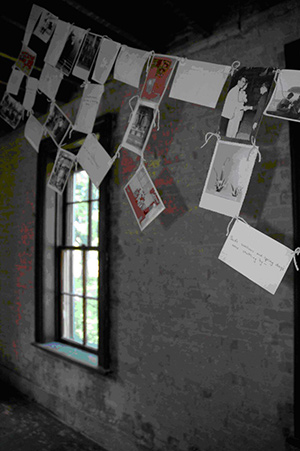 © Mot Coi Di Ve: Wisconsin Installation.Based on Dinh Q. Lê’s work, The Poor Farm, 2010, Wisconsin. Photo by Michelle Grabner.
© Mot Coi Di Ve: Wisconsin Installation.Based on Dinh Q. Lê’s work, The Poor Farm, 2010, Wisconsin. Photo by Michelle Grabner.
Reflections in the Café, Berkeley, October 9, 2010: The Beats
Remembering the Vietnam War brings me back to that period and earlier in my life. Last night I went to see Howl, the new film about Allen Ginsberg, which was showing just a few blocks from where I live in Berkeley.
I attended the film with an old friend of mine, the writer Susan Griffin, whom I had met in 1963, in the post-Howl world of San Francisco, when we were both living in the same North Beach apartment building on the corner of Grant and Greenwich (earlier the building had housed the Bread and Wine Mission). Down the hill were the Café Trieste, the Vesuvio saloon, and Lawrence Ferlinghetti’s City Lights bookstore.
While sitting in the movie house and talking afterwards as we walked away, Susan and I found ourselves flooded with memories of our Bohemian life there and the sense of an abundance of time. We paid very little rent, ate cheaply, and spent much time reading, dancing, and attending demonstrations, poetry and folk music gatherings, and rock and jazz concerts.
This morning in the café, I reread sections of Howl on Trial, a book published by City Lights in 2006.6 I sat imagining this time that, in some ways, set the mood for the San Francisco I knew in the early 1960s.
In August 1955 Ginsberg wrote from San Francisco to his friend Jack Kerouac, then in Mexico City: “The pages I sent you of Howl […] are the first pages put down as is. There is no pre-existent version […] that’s why it’s so messy.”7
Two months later, in October 1955, Ginsberg read the first parts of Howl at the Six Gallery in San Francisco, with Jack Kerouac and Neal Cassidy in the audience. The poem opened: “I saw the best minds of my generation destroyed by madness […].”8
In March 1956 he recorded the completed text at a reading in the Berkeley Town Hall Theater. The following year was the famous obscenity trial, which ended in an acquittal for the poet on October 3, 1957. As Judge Clayton W. Horn ruled: “The theme of Howl presents ‘unorthodox and controversial ideas.’ Coarse and vulgar language is used [. . .] but unless the book is entirely lacking in ‘social importance’ it cannot be held obscene. [. . .] The defendant is found not guilty.”9
At the time of the trial I was living in New York, in Greenwich Village, known for its Beat scene. I seem to have followed the Beats when I moved to San Francisco in 1960. A few years later I would move to Berkeley, the site of so many free speech and antiwar protests. As I resumed my graduate studies in Art History at the University of California, Berkeley (I had dropped out in 1960 from New York University), I was surrounded by demonstrations, street theater, and hippie culture.
At the end of the 1960s, after a year teaching at the University of Indiana, I moved down to Los Angeles, to begin teaching at the University of California, Irvine. There, intensely and passionately, I encountered the women’s movement.
Reflections in the Café, Berkeley, October 10, 2010: Los Angeles, 1970–1976
I sit in the café with two catalogs I have brought with me.
I was age 38 in the fall of 1970 when, as I later wrote, “I plunged headlong into the Southern California feminist world (and to a lesser degree, into the New York one).”10 I belonged to a circle of feminist artists and scholar-critics-curators, and we would eagerly meet to talk, eat, discuss art, life, and new feminist publications, look at one another’s work and writings, and strategize actions. Some of my closest personal friendships were formed at that time, friendships that continue to color my life profoundly.
We boldly took on the L.A. County Museum of Art (LACMA) in 1971, when it mounted its Art and Technology exhibition, with a catalog cover that flaunted the photographs of the sixty-four white male artists in the show. Outraged, we publicly demanded that the museum collect and exhibit much more art by women. Five years later, Women Artists 1550–1950 opened in Los Angeles at LACMA, and I remember standing at the opening, jubilant, weeping with pleasure, and hugging friends.
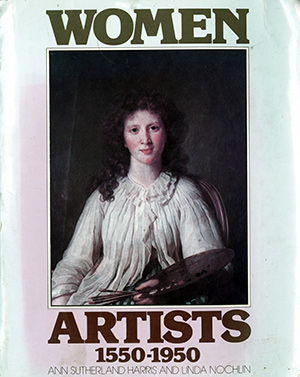 Covers of the two exhibition catalogs: Art and Technology,
Covers of the two exhibition catalogs: Art and Technology,
Los Angeles County Museum of Art (LACMA), 1971,
and Women Artists. LACMA, 1976.
Reflections in the Café, Berkeley, October 11, 2010: News of the Day, New Orleans, 1980 and Berlin, 1981
I sit immersed in the New York Times, reading about economies collapsing around the world, refugees escaping from the horrifying “red sludge” in Hungary, and brutal anti-gay attacks in Serbia and New York City. I turn for relief to an account of the writer Diana Athill who, now age 92, lives in a retirement home, but still writes every day. She talks of having “distilled” her possessions in order to move from her “beloved apartment” to what she calls “an old person’s home.”11
I think of my huge archives and wonder, as I often do, where I should place them and if I should “distill” them as Diana Athill did. I wonder, too, where I will be living in my last years.
As I sit in the café, I begin turning pages of a book I know by heart, The Amazing Decade: Women and Performance Art in America, 1970–1980.
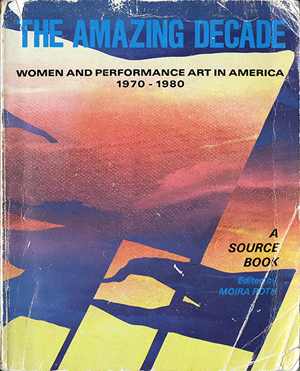 Cover of The Amazing Decade: Women and Performance Art in America, 1970–1980,
Cover of The Amazing Decade: Women and Performance Art in America, 1970–1980,A Source Book, ed. Moira Roth (Los Angeles: Astro Artz, 1983).
It is a book that I edited, based on an exhibition of thirty-eight women performance artists and collectives curated by Mary Jane Jacob in 1980.12 Staged in New Orleans in Louisiana, a state that had repeatedly defeated the Equal Rights Amendment, this exhibition was part of a series of citywide feminist protests.
One of the protests was Suzanne Lacy’s River Meetings: Lives of Women in the Delta. I remember its huge, rowdy potluck banquet, where I sat at a table with black nuns from New Orleans and white lesbians from New York—all talking animatedly together. I remember vividly woman after woman from Louisiana standing up to describe ardently the city’s feminist history. An extraordinary time in an extraordinary city. (As I sit in the Berkeley café, I remember, too, a few years ago making a poignant visit with Suzanne Lacy to New Orleans after the 2005 flooding disaster to help a woman who had been one of the organizers of River Meetings.)
My introduction to the Amazing Decade was based on a lecture (“Frauen in der Performance Kunst”) I had given in West Berlin at Galerie Franz Mehring in 1981 during the Exchange Show—an international series of exhibitions, organized by Carrie Lederer and Gisela Weimann,13 involving women artists of Berlin, Mexico City, and San Francisco. It was not only the first time I had visited Berlin, but also the first time I had in person met a group of German women artists. I hardly slept during the whole time I was there.
In my Amazing Decade introduction I tried to evoke the moment and space of this lecture: “The reader of this highly edited and expanded version of my lecture must imagine its original context—the city of Berlin: now a city divided against itself, once the center of both the Weimar Republic and Nazi Germany—and the audience: for the most part, Berlin women with whom I had spent the previous week talking and exchanging ideas concerning art, politics and life.”14
Reflections in the Café, Berkeley, October 17, 2010: Visiting Derry, Ireland, 1988
I’m pouring through old essays of mine.
In the 1980s I began traveling extensively, usually in the context of feminist conferences and gatherings, formal and informal. In 1988, for the first time since I was a child, I visited Ireland and spoke at an Irish feminist conference, organized by Pauline Cummins and other women artists from the North and the South. It was held just north of the border, in Derry, a town that I was later to describe in an essay as a “devastating world of day-and-night armored patrol trucks and soldiers with drawn guns.”15
At the conference one image, by Louise Walsh, stunned me. It was a drawing of two nude women in a boat.
As I later wrote, “Perhaps if I had seen the image anywhere but in Derry I might have first read it as an invocation of ancient Irish heroines on some ritual journey, but in this context, it had a fiery contemporary sense of defiance to it. In Walsh’s image, water and nothing else surrounds the two women. The bodies of the older and younger women appear almost fused to the tub-like vessel. They hold it together with their entwined limbs as the vessel rides—the younger at the boat’s prow—over the rough-waved sea.”16
Reflections in the Café, Berkeley, October 21, 2010: Judy Baca’s Vision of the Future without Fear
I find myself no longer seeing in my mind’s eye the harshly divided Ireland of the late 1980s, but rather the volatile Soviet Union of 1990. (The Soviet Union dissolved the next year, two years after the fall of the Berlin Wall in November of 1989.) I sit here immersed in memories of Judy Baca and me—it is January of 1990 and we are in the Soviet Union attending a conference and meeting artists, when we visit the Cossack painter Alexi Begov in his Moscow studio.
Through an interpreter Baca, the Los Angeles-based muralist, talks ardently with Begov, describing to him her grand plans for a huge traveling mural installation that will represent a peaceful “future without fear.” I am deeply moved—listening, videotaping, and taking many notes about the exchange.
World Wall: A Vision of the Future without Fear will eventually consist of a double-layered semicircle of portable canvas panels, each 30 x 10 feet. Seven panels created by Baca will face inward, and seven panels made by artists from around the world, selected by Baca, will face outward. She will provide each artist or artist group with materials (canvases and paint), but they will have total freedom in their choice of imagery.
Excitedly Begov brings out canvas after canvas with heavily impastoed surfaces of dark blues and blacks interrupted by occasional flashes of brighter colors. Baca is most drawn to his End of the Twentieth Century series of blind men, women, and children. Would Alexi be interested in contributing a panel to the World Wall, she asks, assuring him that “if part of your piece is dark, and out of it comes light, or if you paint an Iron Curtain with a tear in it, it’s your business.” We end our long visit of several hours in Begov’s studio by toasting with champagne “to our common language […] for art to influence people.”17
In the spring of 1990, fascinated by Baca’s project (which she had begun in 1986, intensely, as is her mode, working with historians, students, and artists18), I make two visits from Northern California to Baca’s studio in Los Angeles to see the progress of the World Wall. By April two canvases are finished (Balance and Triumph of the Hearts) and two are in process (Triumph of the Hands and Nonviolent Resistance).
In June Baca and I attend an international gathering in Finland, “Meeting of the Worlds,” at Joensuu, a town 50 miles from the Soviet border, where the World Wall is first premiered. A conference is held in the huge semicircle of Baca’s four completed canvases plus one created jointly by three Finnish artists.19
Baca is the first speaker, and she tells the audience that this gathering within the World Wall is “part of what I dream.” She goes on to talk of her dream, with her World Wall collaborators from around the world: “By the use of universal symbols, we hope to overcome the language difficulties of an international audience and create a codified message of alternatives and hopes. It is my belief that my collaborators and I will play an important role in the invention of a new language of the heart.”
I sit here in this Berkeley café vividly seeing Baca’s Triumph of the Hearts, remembering the first time I saw it in her Los Angeles studio, and then as part of the Finnish installation. I remember how I and so many of the international audience members were riveted by its four close-up faces and the heart-shaped irises of their eyes, and by the figure to the right striding out to combat the “winds of war” as his shadow falls to the ground and turns into a silhouette of Mahatma Gandhi.
Now in California twenty years later, I continue to be inspired and moved by Judy Baca’s visions of triumphant hearts.
Reflections in the Café, Berkeley, October 26, 2010: Traveling Companions/Fractured Worlds
As I come to an end of these reflections, I sit thinking about the many traveling companions in my life: my father and mother; friends and lovers; my fictional companion of the last nine years, the Czech-Jewish writer Rachel Marker; and the vast group of writers and artists (both living and dead) who have inspired me.
And in this American Studies Journal issue I will have the great pleasure of four fascinating new traveling companions—as we describe how we wended our ways through space and time to the United States: from Turkey to Ohio (Güneli Gün), from Iran to New York City (Nahid Rachlin), from Jordan to Michigan and on to Cyprus (Lisa Suhair Majaj), from Germany to Washington, DC (Mindy Weisel), and from England to California (myself).
Now it is time for me to return to my various unfinished series that have allowed me to explore such grand themes as time and space, history and memory—a journey that I invite you to join on my website at http://moiraroth.com.
Reflections in the Café, Berkeley, October 27, 2010: Of Shadows, Mirrors, and Shared Times
As I am fascinated with shadows and mirrors—they run through my recent writings as recurring images and metaphors—I want to leave you, dear readers, with these three last images, taken respectively in Paris, Berlin, and Manawa, Wisconsin.
In the summer of 2006, I visited Germany (Potsdam, Tubingen, Nuremberg, Munich, and Berlin), and later Prague and Paris, traveling mainly by train, and writing in the various cities—in cafés and cemeteries. While in Prague’s Old Town, and writing in a café opposite the Astronomical Clock, I introduced the characters of the Mute Players into my ongoing narrative about Rachel Marker. A few days later, in Paris, living in a studio apartment with a large mirror, which I passed frequently on my way out to visit the nearby Montparnasse Cemetery, I composed “Letters to the Dead,” a script that Rachel Marker writes for the Mute Players. This play, intended to last one hundred years, involves the Players choosing a series of words significant to them and each day laying individual letters for these words on graves in various cemeteries.
I took a series of “shadow” photos while staying at the European Academy in Berlin to attend a conference there. Conceived by Gisela Weimann, the project Shared Times, comprising the conference, an exhibition, and later a publication, had spiraled out from a narrative about seven women artists (including Weimann), based in Berlin, who had met around 1968 and had kept in touch since then. Weimann invited a group of Berlin-based women to supply seven questions each (to be answered by the Shared Times artists) and also asked six feminist scholars from outside Germany (myself included) to participate in the conference and publication. For days we sat and talked, formally and informally, took walks and rides around the city together, all the while talking about history, particularly women’s history, as we (literally and metaphorically) “shared times.” This experience in Berlin profoundly rooted me yet again not only in European history and spaces, but also in the concept of “shared times”—Geteilte Zeit.
Notes
1 See http://poorfarmexperiment.org/index.html (accessed December 16, 2010).2 See the Persimmon Tree—an online journal, based in Northern California, devoted to work by women over 60—my introduction to a selection of Ringgold’s art and the images themselves: Moira Roth, “About Faith Ringgold,” Persimmon Tree (Summer 2007), http://www.persimmontree.org/articles/MoiraRoth_AboutFaithRinggold.php (accessed November 15, 2010), and Faith Ringgold, “Visual Art,” Persimmon Tree (Summer 2007), http://www.persimmontree.org/articles/Art_FaithRinggold.php (accessed November 15, 2010).
3 Dinh Q. Lê, e-mail to author, 26 September 2010.
4 Moira Roth, “Cuoc Trao Doi Giua/Of Memory and History: An Exchange between Dinh Q. Lê and Moira Roth, June 1999–April 2003” and “Biography,” in Dinh Q. Lê: From Vietnam to Hollywood, ed. Christopher Miles and Moira Roth (Seattle: Marquand Books, 2003). My other writings on this artist include “Of Dinh Q. Lê, United States, Vietnam, and Cambodia,” in Persistent Vestiges: Drawing from the American-Vietnam War, ed. Catherine de Zegher (New York: Drawing Center, 2006), 80–94; “The Obdurate History of Mot Coi Di Ve (‘Spending One’s Life Trying to Find One’s Way Home’),” in A Tapestry of Memories: The Art of Dinh Q. Lê, ed. Sigrid Asmus (Bellevue, WA: Bellevue Art Museum, 2007); and “Traveling with Dinh Q. Lê Through Time and Space,” in 12 Contemporary Artists of Vietnam, ed. Dao Mai Trang (Ho Chi Minh City: Gioi Publishers, 2010), 160-81.
5 This Wisconsin Installation was conceived and begun in July 2010 by Maryellen Herringer, Rebecca Jennison, Chuck Mobley and Modesto Covarrubias.
6 Bill Morgan and Nancy J. Peters, eds. Howl on Trial: The Battle for Free Expression (San Francisco: City Lights, 2006).
7 Allen Ginsberg to Jack Kerouac, August 1955, in Howl on Trial: The Battle for Free Expression, ed. Bill Morgan and Nancy J. Peters (San Francisco: City Lights, 2006), 33.
8 Allen Ginsberg, in Howl on Trial: The Battle for Free Expression, ed. Bill Morgan and Nancy J. Peters (San Francisco: City Lights, 2006), 21.
9 Clayton W. Horn, “The Decision,” in Howl on Trial: The Battle for Free Expression, ed. Bill Morgan and Nancy J. Peters (San Francisco: City Lights, 2006), 197, 199.
10 Suzanne Lacy and Moira Roth, “Exchanges,” in Art, Women, California, 1950–2000: Parallels and Intersections, ed. Diana Burgess Fuller and Daniela Salvioni (Berkeley: University of California, 2002), 296.
11 Sarah Lyall, “In Life’s Latest Chapter, Feeling Free Again,” New York Times, 11 October 2010, C 3.
12 Moira Roth, ed. The Amazing Decade: Women and Performance Art in America, 1970–1980, A Source Book (Los Angeles: Astro Artz, 1983). This book (the first on the subject) consists of short entries (accompanied by photographs) on 38 women artists and collectives, my introduction, an introduction by Mary Jane Jacob, and an extensive bibliography and chronology, beginning in 1770 (when the Daughters of Liberty group was formed to support the American Revolution) and tracing events in general history, women’s history, and the history of women’s performance through 1979.
13 Weimann was to provide me with three further fascinating opportunities to visit Berlin. On behalf of the Women’s European Academy of Art and Research, she invited me to be part of a conference at the House of Cultures of the World in 1997, and in 2001 I took part in a symposium on Weimann’s own art, held at Berlin’s Amerika Haus. Finally, in 2008 she organized a conference, “Shared Times, Art History and International Dialog” at the European Academy. My presentation, “Widening the Spiral,” was later translated and published as: Moira Roth, “Die Erweiterung der Spirale: Nachsinnen und Lesen in einem Café in Berkeley,” in Geteilte Zeit: Fragen und Antworten, ed. Gisela Weimann (Weimar: VDG, Ed. Eselsweg, 2008), 226–36.
14 Moira Roth, ed. The Amazing Decade: Women and Performance Art in America, 1970–1980, A Source Book (Los Angeles: Astro Artz, 1983), 14.
15 Moira Roth, “Two Women: The Collaboration of Pauline Cummins and Louise Walsh, or International Conversations Among Women,” in Sounding the Depth: A Collaborative Installation by Pauline Cummins and Louise Walsh, ed. Pauline Cummins (Dublin: Irish Museum of Modern Art, 1992), 7.
16 Moira Roth, “Two Women,” 7.
17 I have drawn these direct quotes from a text (composed mainly of journal entries of 1990–1991) that I wrote describing my firsthand experiences in Russia, Finland, and Los Angeles with the World Wall project: “New Language of the Heart: Five Moments in the Planning and Making of the World Wall” in Judy Baca: World Wall, A Traveling Mural Installation (Los Angeles: SPARC, 1991). I also conducted a long interview with Baca about the World Wall, an edited version of which was published in “Toward a World in Balance: A Conversation with Judy Baca, Parts 1 and 2,” Artweek, 14 November 1991, and 21 November 1991.
18 Baca’s earlier huge mural project, the Great Wall of Los Angeles, begun in 1976 (and still unfinished in 2010), has been a deeply collaborative project, based on extensive research of historians and the many sketches of Baca, and executed by teenage students led by Baca and other artists. Painted on a long wall that runs beside a drainage canal, it consists of scene after scene, beginning in prehistoric times and tracing the multiethnic history of the city.
19 Later in the summer of 1990, these five murals are brought to Moscow, and, together with Begov’s End of the Twentieth Century panel, are exhibited there in Gorky Park. Then, in April 1991, the panels are shown in East Los Angeles’ Plaza de La Raza before the exhibition travels to Washington, DC, to be installed at the Smithsonian’s Experimental Gallery. By 2010, although still incomplete, the World Wall project contains, in addition to Baca’s seven panels, panels from Russia, Finland, Palestine/Israel, and Mexico, and is in the midst of an exchange with Canada.
Author
Suggested Citation


